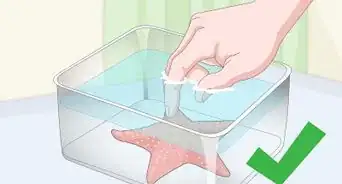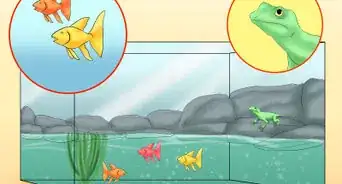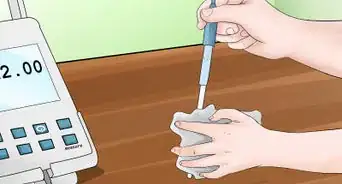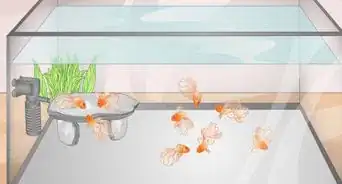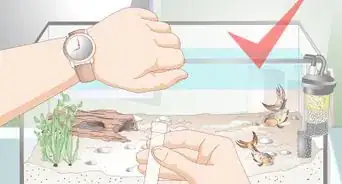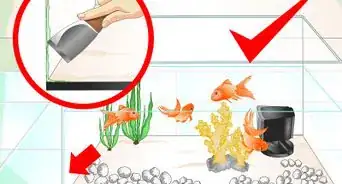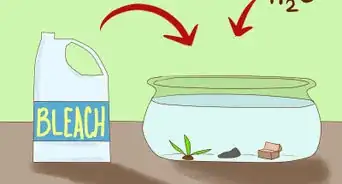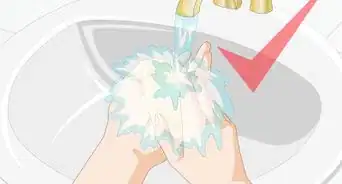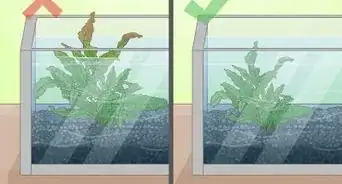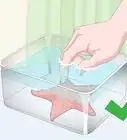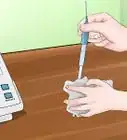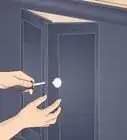X
wikiHow is a “wiki,” similar to Wikipedia, which means that many of our articles are co-written by multiple authors. To create this article, 12 people, some anonymous, worked to edit and improve it over time.
This article has been viewed 102,920 times.
Learn more...
Undergravel filters, some love them, some hate them. But for less that $30 you can build a biological/mechanical filter for your 5-1/2, 10, 20, or even 30 gallon (113.6 L) tank! If you've got more money, and more time, you can build an UGF for any size tank.
Steps
-
1Know the size of your tank. Measure its length width and height.
-
2Plan. Try to think of a design that would allow the PVC to make a closed circuit, and cover a good amount of area. Also leave about a half inch from the sides of the tank and the PVC tubing, as this will allow your substrate to fill in the gap hiding the UGF. Making a closed circuit simply cuts a few dollars off the price of the build by not having to buy caps. Double check to be sure.Advertisement
-
3Go out to your local hardware store and pick up lengths of 1/2" or 3/4" PVC. My local store sold it in 10' lengths, and it cost > $2.00. 1/2" would be best for 5 1/2 - 20 gallon tanks. 3/4" would be better for 30 or more gallon tanks. Make sure you have all of the elbows and T connectors you'll need. Take into account the lift tubes, which will need 1 T connector for each lift tube
-
4While at the hardware store, ask the clerk where you can get PVC cutters, I got a decent pair for $6.87. Try to get the kind that ratchet, it will make cutting easier.
-
5Once you've got the filter pattern planned out, begin cutting and assembling the pieces outside of the empty tank.
-
6After all pieces are assembled, use a hammer and nail, or a power drill to punch holes into the bottom of the PVC pipes. This will allow water to be drawn into the UGF as it operates. Be careful not to hurt yourself, or go through the other side of the PVC pipe.
-
7Now take the completed UGF and put it into the fish tank. Make sure the uplift tubes are not sticking out of the tank.
-
8Run the air tube(s) down to the bottom of the uplift tube(s). For PVC pipe 1" or greater in diameter attach an air stone at the end of the air tube and drop that into the uplift tube.
-
9Using proper techniques, finish setting up the aquarium (washed gravel, de-chlorinated water, additional power filter (if desired).
Advertisement
Community Q&A
-
QuestionI'm building a reverse flow UGF for my Malawi tank. What size should the holes be as the filter is for a 3x2 foot tank?
 Aussie JCommunity AnswerAs big as you need. It depends on the size of tubing of the filter in question. They need to be large enough that water will flow, but not so large that gravel falls through.
Aussie JCommunity AnswerAs big as you need. It depends on the size of tubing of the filter in question. They need to be large enough that water will flow, but not so large that gravel falls through. -
QuestionWill this work for a dirt planted tank? Or can I run old nylons on the pipes to keep the dirt from entering the system?
 Community AnswerThis should work with gravel or soil, anything loose should work great. You can use nylons to be sure.
Community AnswerThis should work with gravel or soil, anything loose should work great. You can use nylons to be sure. -
QuestionIs there a filter that I connect PVC pipe to?
 Community AnswerOnly ones that you make yourself. That the best way to do it to suit your needs. I used an aquaponics grow pot with the filter floss and a PVC reducer that fits the pot.
Community AnswerOnly ones that you make yourself. That the best way to do it to suit your needs. I used an aquaponics grow pot with the filter floss and a PVC reducer that fits the pot.
Advertisement
Warnings
- UGFs will absolutely not work with sand substrates.⧼thumbs_response⧽
- There are many different points of view on the usefulness of an UGF. Take time to consider both the pros and cons. If you have the opportunity, it would be far better to try an UGF on a smaller tank first if you're not sure.⧼thumbs_response⧽
- If you are not yet comfortable with the idea of an undergravel filter, or still new to the fish keeping hobby please be absolutely sure that you can complete a DIY aquarium project. If you do not know what you are doing, use the wrong materials, or do something wrong you may end up polluting or poisoning your aquarium, or further complicating matters.⧼thumbs_response⧽
Advertisement
Things You'll Need
- You will need -
- PVC pipe of the appropriate size
- PVC pipe cutters
- PVC pipe fittings (elbows, T sections/connectors)
- Hammer and nail or an electric drill.
- Aquarium air pump and air tube (if using 1" or greater diameter PVC pipe airstones may be used in the uplift tubes)
- Caution with power tools. It is always recommended to have supervision and use appropriate safety gear.
About This Article
Advertisement









